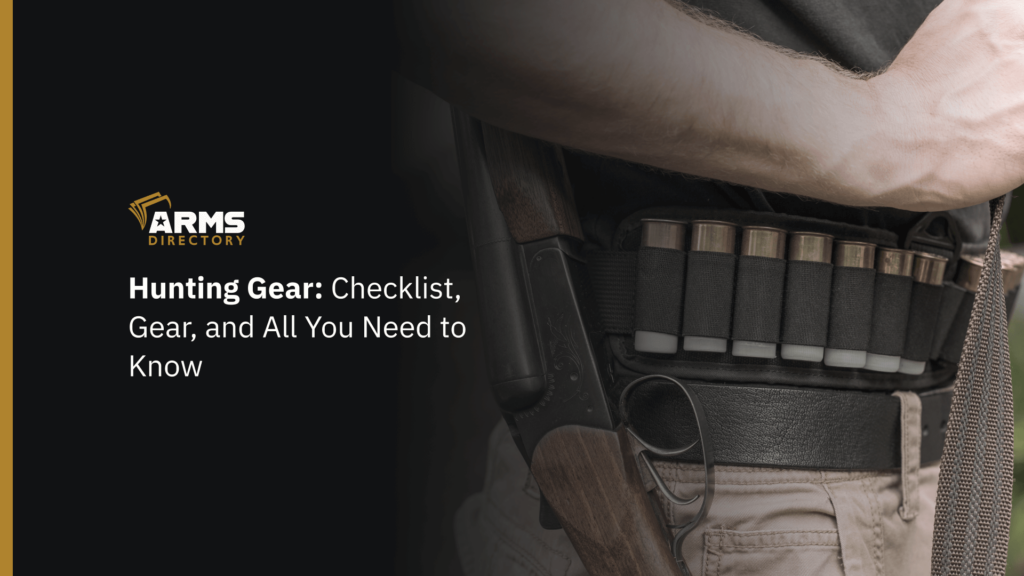
Hunting Gear: Checklist, Gear, and All You Need to Know
Before you head out into the wild, take a moment to relax and double-check your hunting gear. Trust us, there’s nothing worse than realizing your ammunition pouch is empty just when you need it the most.
So, in this article, we are going to make sure you don’t end up unprepared. We’ve got your back with all you need to know about hunting gear, rifles, shooting accessories, as well as an essential hunting checklist good for whether you’re after deer, moose, rabbits, or birds.
We’ll walk you through everything to help you bag your game and get back before the sun sets. Keep reading!
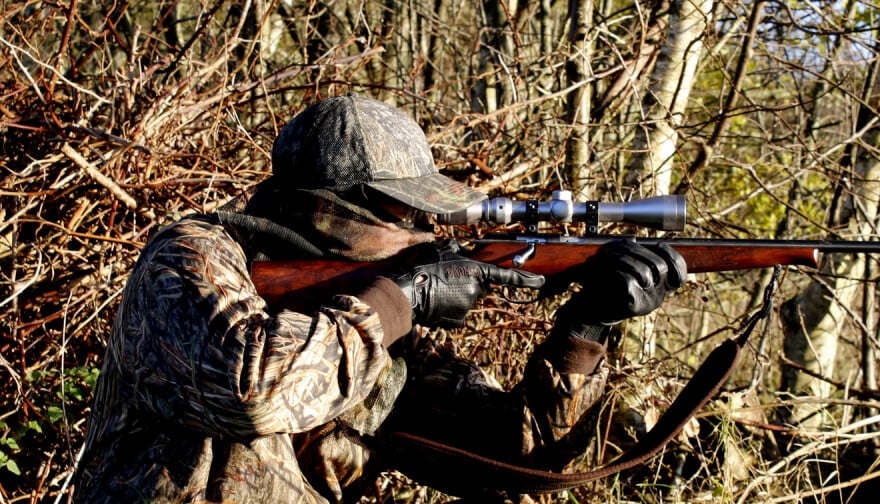
Essential Hunting Gear Explained
Every hunter, whether a beginner or seasoned shooter, requires essential gear. We’re not just talking about the best hunting rifle or the contents of the backpack, but also the fundamental preparedness for the hunting trip, ensuring a safe return home.
Before listing a checklist, let us guide you through the main categories of preparedness for hunting.
Hunting Tools and Firearms
Hunting Tools
A knife is an absolute necessity for a hunter. You have three options: fixed blades, folding knives, or multi-tool. Additionally, carrying knives with replaceable blades is becoming popular.
The choice is up to you. Fixed blades are larger, easy to maintain, and more durable. Folding knives are easy to pack, come with multiple blade types, and are lightweight. Multi-tools provide an all-in-one experience with options such as scissors, saw, and screwdriver. Replaceable blades offer the advantage of easily replacing the blade when it becomes dull, rather than needing to sharpen it in the field.
Here are three of the top performing brands in the U.S: Benchmade, KA-BAR, and Buck Knives. At Arms Directory you can find many businesses across the country dealing with hunting knives too.
Types of Hunting Guns
You don’t go after a big game with the wrong gun. That’s why there are several different types of hunting firearms designed for various hunting purposes:
- Shotguns are a popular choice for bird hunting and small game. They are typically classified by their gauge, which refers to the diameter of the barrel. The most common gauges are 12, 20, and .410.
- Rifles are one option for big game hunting. They are more accurate than shotguns and can be used at longer ranges. Rifles are also classified by caliber, which refers to the diameter of the bullet. Examples include .30-06, .308, and .270.
- Muzzleloaders are guns loaded from the muzzle (the open end of the barrel) rather than the breech (the back end of the barrel). They are typically used for hunting big game and are favorite among traditionalists.
- Handguns are smaller firearms that are designed to be fired with one hand. They are typically used for self-defense and sport shooting, but can also be used for hunting small game. Handguns are classified by their caliber, or the diameter of the bullet. Popular calibers for handguns include .44 Magnum such as the big game hunting pistol Auto Mag and .357 Magnum.
Types of Hunting Rifles
Let’s take a look at the most common and best types of hunting rifles:
- Bolt-action rifles are the most popular type of hunting rifle. They are manually operated, the shooter must rotate the bolt to load, then open the breech to fire, and extract or eject any spent cartridges. Examples of such rifles are the Remington Model 700 and the Savage Model 110.
- Lever-action rifles are popular because of their speed and reliability. They use a lever to cycle the cartridges, which makes them faster to shoot than bolt-action rifles. Popular lever-action rifles include the Marlin 336 and the Winchester Model 94.
- Semi-automatic rifles automatically cycle through the cartridges after each shot. They are known for their speed and ease of use. They are also popular among small game Hunters. Favorite semi-automatic rifles include the Ruger 10/22 and the Browning BAR.
Hunting Clothing and Footwear
Hunters understand the significance of appropriate clothing and footwear for a successful and comfortable hunting experience. When determining the most suitable gear, you should take several factors into account:
Weather-Appropriate Clothing
- Layering allows you to adjust what you are wearing based on the temperature or weather, ensuring comfort and protection.
- Investing in waterproof clothing is essential, as hunters often encounter wet and muddy terrains.
- Camouflage clothing helps you blend into your surroundings, making it easier to approach and remain undetected by wildlife.
Quality Hunting Boots
- Quality hunting boots are designed to navigate diverse terrains, offering stability, support, and protection.
- Hunting often involves long hours of walking and standing. High-quality boots with adequate cushioning and ankle support reduce fatigue, preventing discomfort and potential injuries, allowing hunters to focus on their pursuits.
- Insulated and waterproof boots are essential for warmth and keeping your feet dry in varying weather conditions.
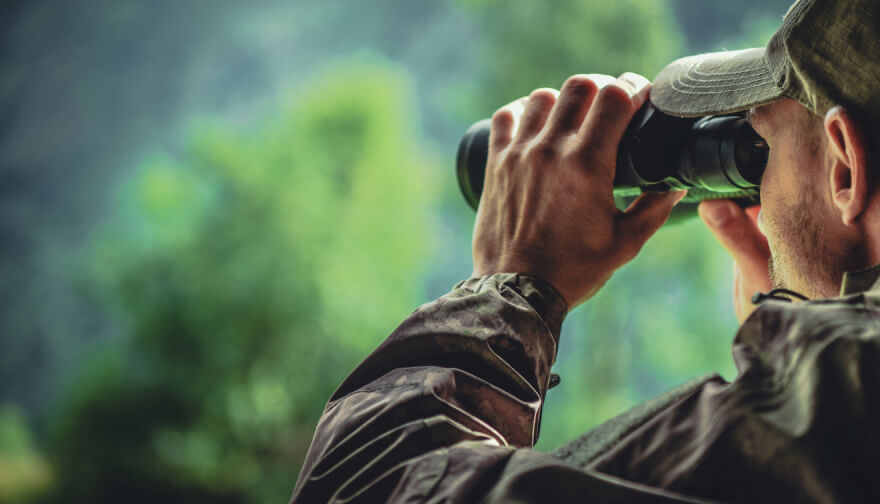
Gun Optics and Navigation Tools
Having the right optics and navigational tools can greatly enhance the overall experience and chances of success. A few essential components in this regard are binoculars and scopes for optics, and GPS devices and maps for navigation.
Binoculars and Gun Scopes
When it comes to spotting and targeting from a distance, binoculars and gun scopes are indispensable. Binoculars provide the ability to observe wildlife from afar while scopes provide precise aiming and shooting capabilities.
When choosing, look for products with features such as high magnification, superior lens coatings, and durable construction. You can always rely on top U.S brands such as Vortex Optics, Leupold, or Bushnell.
GPS Devices and Maps
You don’t want to go into the wilderness without a GPS device, compass and maps.
GPS devices offer real-time positioning and tracking, allowing hunters to mark waypoints, track their routes, and navigate back to camp or a specific location. They also provide valuable information such as elevation, topography, and trail maps, aiding in route planning and exploration.
A cost-effective option to using a GPS unit is having the onX Hunt App on your smartphone. With Offline Maps, you can access your location, save Waypoints, and use all Layers and Tools even without cellular service.
Traditional maps and compasses are also essential backup tools. Even as modern navigation technology advances, the conditions can change rapidly, making old-school navigation life-saving. Don’t overlook the value of including them in your backpack.
Hunting Accessories
Here are a couple of essential hunting accessories that can up your hunter’s game.
Hunting Calls and Decoys
Whether you’re going after ducks, deer, or turkeys, having the right calls can help attract your prey. One of the best U.S brands for high-quality hunting calls is Flextone.
Decoys, on the other hand, are a great way to add a visual element to your hunting strategy. Consider Montana Decoy, as it is one of the best U.S brands on the market.
Hunting Scent Control Products
You know animals have an incredibly keen sense of smell, which can make or break your hunt. This is where hunting scent control products come into play. These products, such as scent-eliminating sprays, detergents, and clothing, work to minimize your smell as a human being, giving you the upper hand tickets at staying undetected.
Emergency and Survival
Carrying the essential emergency and survival items can make a significant difference in ensuring your safety. Here are some important items and tools to consider when you go hunting:
First aid kit: Pack a comprehensive first aid kit containing bandages, antiseptic wipes, gauze, adhesive tape, pain relievers, and any personal medication you may need.
Fire-starting tools: Waterproof matches, lighters, or a fire starter kit can help you build a fire for warmth and cooking, or when there is an emergency and you need to signal for help.
Emergency shelter: A lightweight, compact emergency shelter such as a space blanket or a bivy sack can provide protection from the elements in case you ever get stranded or lost.
Water purification kits: A portable water filter or water purification tablets are a lifesaver when your supply of drinking water runs out or becomes contaminated.
Selecting the Right Hunting Weapons
When choosing the right gun for you, there are two major factors to consider: environment and budget.
Understanding Your Hunting Environment
Where and when you go hunting are going to determine the type of firearm you should use.
Here are two examples of common hunting environments and the firearms that are best suited for them:
- Woodland hunting: In a woodland environment, you need a firearm that is lightweight and easy to maneuver. Shotguns and rifles with shorter barrels are ideal for this type of hunting. Some popular choices include the Remington 870 shotgun and the Ruger American rifle.
- Open field or mountain hunting: When hunting out in the open, you need a firearm that can shoot accurately over long distances. Bolt-action rifles, like the Tikka T3x and Browning X Bolt, are popular choices for this type of hunting.
Budget Considerations
It’s important to balance quality against affordability when choosing the hunting weapon that’s right for you.
Here’s what to consider:
- Balancing quality and affordability: It’s always a good idea to not only choose the best gun within your price range, but also one that suits your needs. Some popular firearms that offer such balance include the Savage Axis and the Mossberg Patriot.
- Long-term investment: Consider purchasing a firearm that can be used for multiple types of hunting. This will save you money in the long run such as Winchester Model 70 and the Weatherby Vanguard.
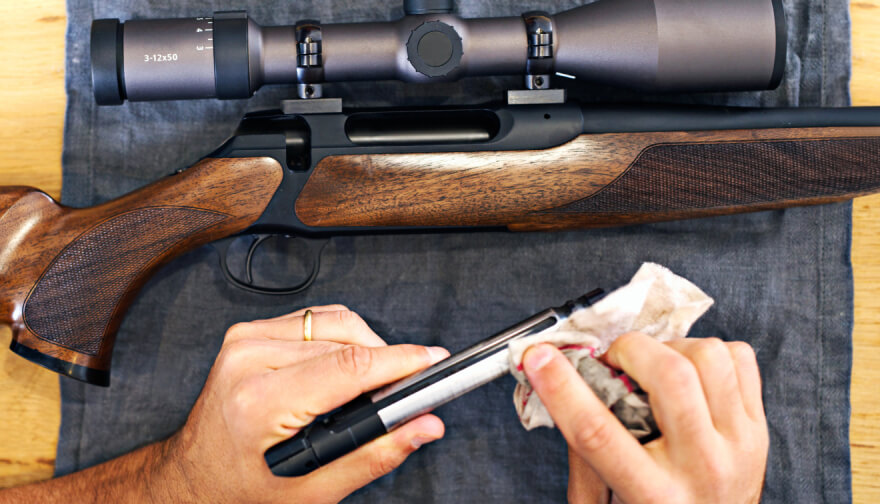
Maintenance and Care of Hunting Gear
Following essential firearm safety rules and proper maintenance and care is essential to ensure that your equipment lasts for years to come.
Cleaning Firearms
Cleaning your guns regularly is important so that they function effectively and safely.
Here are some tips:
- Always unload your firearm and double-check that it’s unloaded before you clean it.
- Use a cleaning kit that includes cleaning solvent, lubricant, bore brush, patch holder and patches, cleaning rod, nylon cleaning brush, flashlight, cotton swabs, and microfiber cloths for polishing.
- Clean your gun in a well-ventilated area to avoid inhaling noxious solvent fumes.
- Follow the manufacturer’s instructions for disassembling and cleaning your firearm.
Regular Maintenance of Optics and Tools
Here are a few tips for maintaining your optics and other tools:
- Use gloves when handling almost any unmounted optical component.
- Use optical tweezers and vacuum tweezers to handle smaller parts.
- Clean your optics with a soft brush and lens tissue.
- Store them in a dry, dust-free environment.
- Clean your tools with a soft brush and a mild detergent.
Easy Hunting Gear Checklist
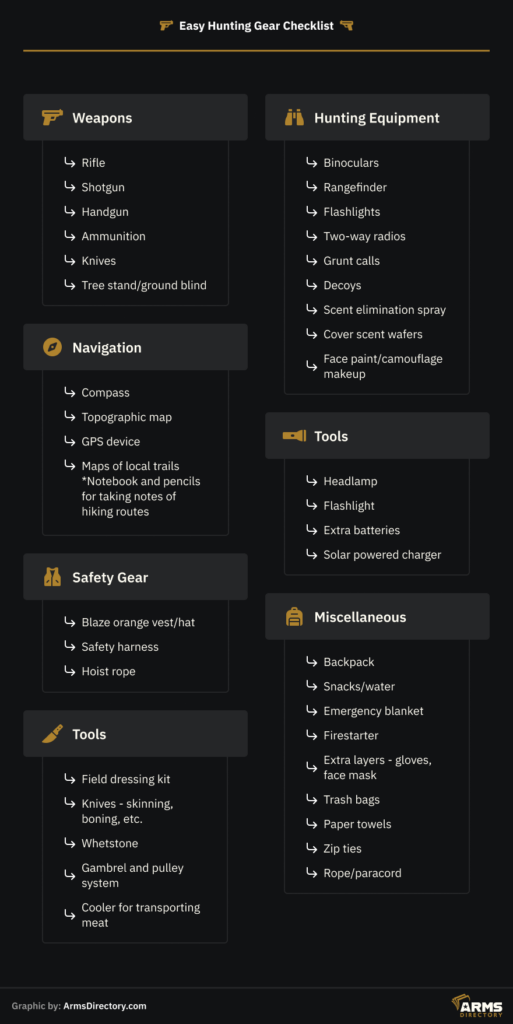
While this list is not exhaustive, it should give you a good starting point. Remember, hunting essentials vary based on a few different things: the game you’re after, hunting region, the weather, and how long you plan to be on your hunting trip.
Weapons:
- Rifle
- Shotgun
- Handgun
- Ammunition
- Knives
- Tree stand/ground blind
Hunting Equipment:
- Binoculars
- Rangefinder
- Flashlights
- Two-way radios
- Grunt calls
- Decoys
- Scent elimination spray
- Cover scent wafers
- Face paint/camouflage makeup
Navigation:
- Compass
- Topographic map
- GPS device
- Maps of local trails *Notebook and pencils for taking notes of hiking routes
Safety Gear:
- Blaze orange vest/hat
- Safety harness
- Hoist rope
Tools:
- Field dressing kit
- Knives – skinning, boning, etc.
- Whetstone
- Gambrel and pulley system
- Cooler for transporting meat
Illumination:
- Headlamp
- Flashlight
- Extra batteries
- Solar powered charger
Miscellaneous:
- Backpack
- Snacks/water
- Emergency blanket
- Firestarter
- Extra layers – gloves, face mask
- Trash bags
- Paper towels
- Zip ties
- Rope/paracord
Wrap Up
Having the proper hunting gear and equipment is crucial for a safe, effective, and legal hunt. Carefully research everything before selecting firearms, optics, navigation tools, protective clothing, emergency supplies, and more.
Where you hunt is as important as when you hunt. Maintain all your gear properly -not only for longevity, but so that there will be no unpleasant surprises along the way. There’s nothing more disappointing than a gun that doesn’t work properly when you need it the most. Finally, and most importantly, don’t ever head into the wilderness unprepared. This guide can help you equip yourself for a successful day of hunting.

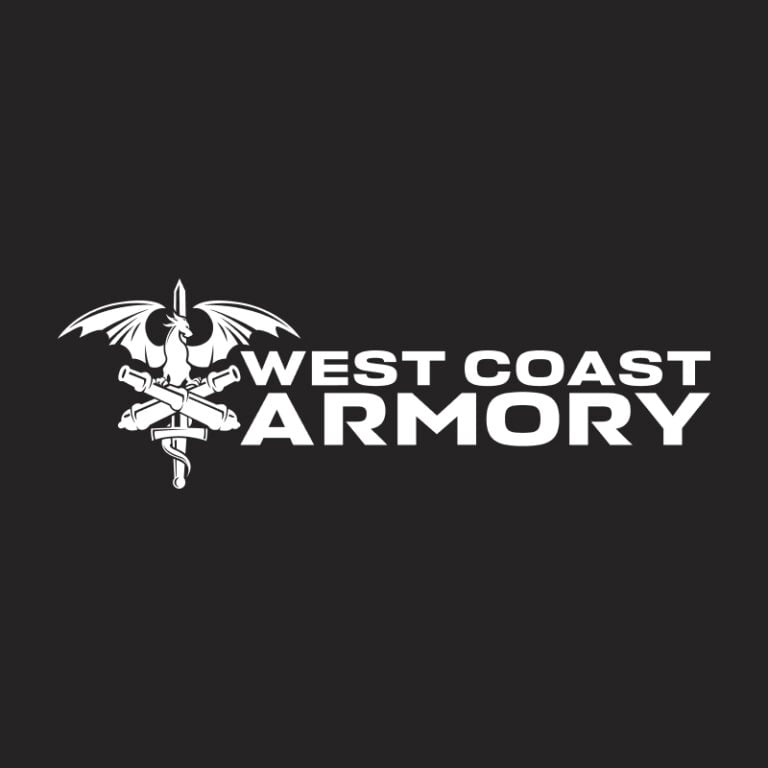
![The Ultimate Shooting Accessories for Every Weapon [A 2023 Beginners Guide]](https://vault.armsdirectory.com/wp-content/uploads/2023/08/30071223/The-Ultimate-Shooting-Accessories-for-Every-Weapon-A-2023-Beginners-Guide-1024x576.png)
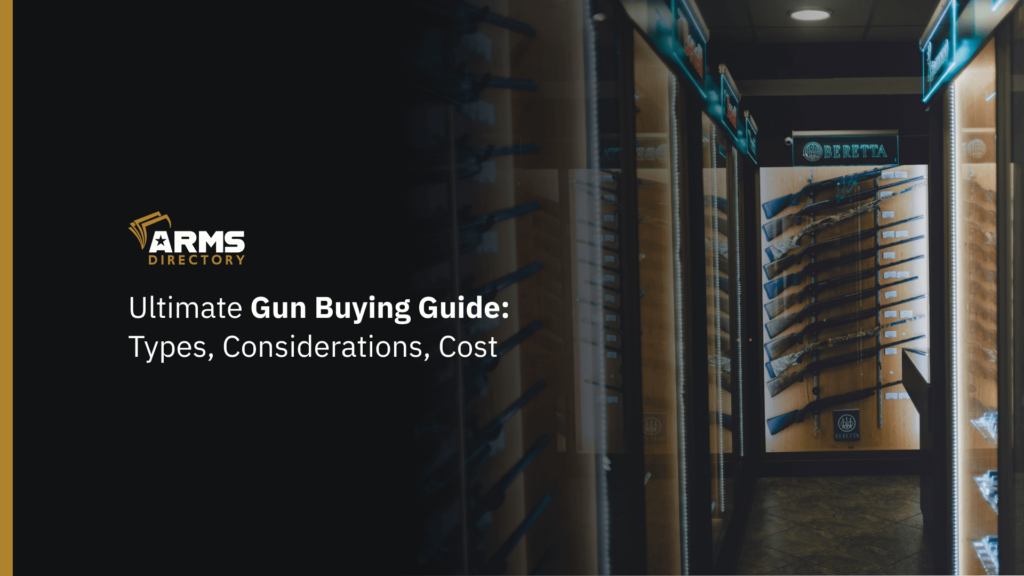
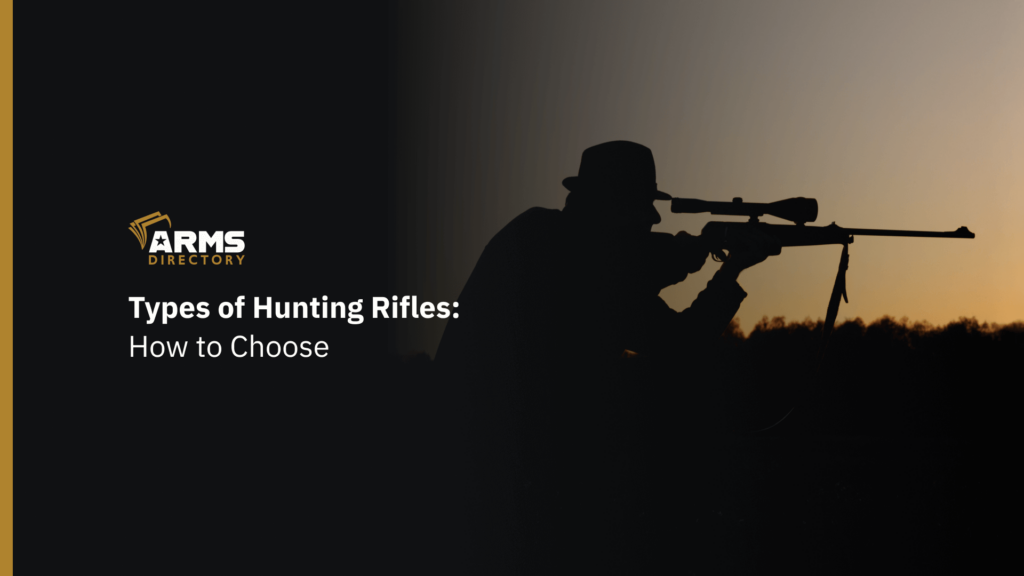
![Close Encounters Shotgun for Home Defense [2024 Guide]](https://vault.armsdirectory.com/wp-content/uploads/2024/02/06060541/Close-Encounters_-Shotgun-for-Home-Defense-2024-Guide-1024x576.png)
![The Right Way to Buy and Sell Firearms Online [Guide]](https://vault.armsdirectory.com/wp-content/uploads/2023/10/20050323/The-Right-Way-to-Buy-and-Sell-Firearms-Online-Guide-1-1024x576.png)